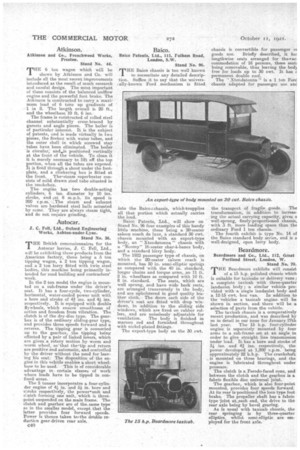Autocar.
Page 30

If you've noticed an error in this article please click here to report it so we can fix it.
• J. C. Fell, Ltd., Oxford Engineering Works, Ashtomunder-Lyne. Stand No, 36.
THE British concessionnaires for the Autocar lorries, J. C. Fell, Ltd., will be exhibiting three products from the American factory, these being a 5 ton tipping wagon, a 2 ton tipping wagon, and a 2 ton lorry fitted with twin steel bodies, this machine being primarily intended for road building and contractors' Work.
In the 2 ton model the engine is mounted an a sub-frame under the driver's seat. It has a four-cycle, two-cylinder, horizontal, water-cooled power unit with a bore and stroke of 4,i ins, and tg ins. respectively. It is equipped with double flywheels, which ensure smoothness of action and freedom from vibration. The clutch is of the dry-disc type. The gearbox is of the ordinary sliding-gear type, and provides three speeds forward and a reverse. The tipping gear is connected up to the gearbox, the tipping being effected by a pair of linked levers, which are given a rotary motion by worm and worm wheel, so'that the'tip and return are positive and automatic, and controlled by the driver without the need for leaving his seat. The disposition of the engine in this vehicle enables a short wheelbase to be used. 'This is of considerable advantage in • certain classes of work where loads have to be tipped in confined areas.
The 5 tonner incorporates a four-cylinder engine at 44 in. and 4 in. bore and stroke respectively, the power'-unit and clutch forming one unit, which is threepoint suspended an the main frame. The eluteh and gearbox are of the, same type" as in the smaller model, except that the latter provides four forward speeds. Power is thence taken toethe double reducticn gear-driven rear axle.
C41)




















































